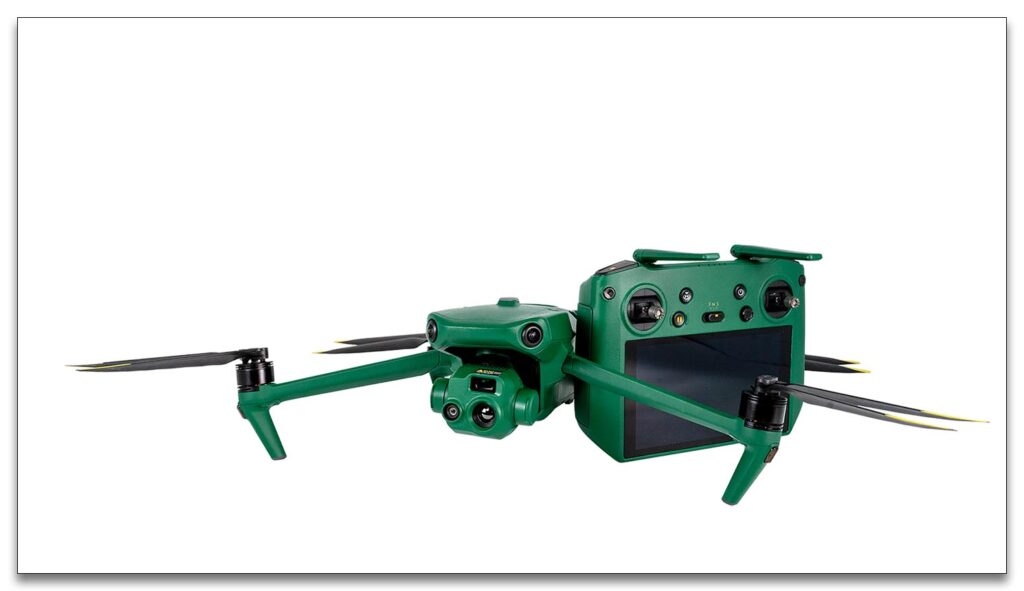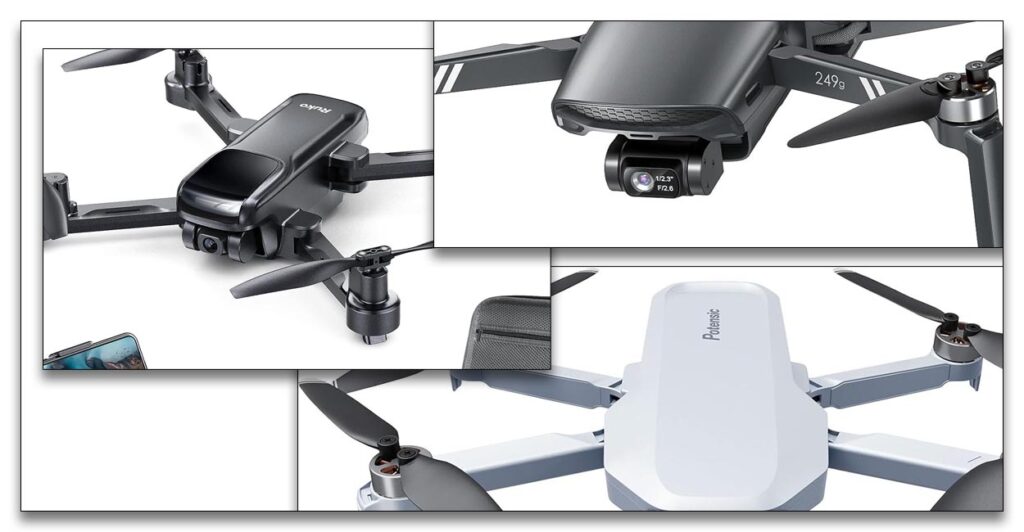No, it’s not “for” First Responders, not at all!
(More on that later.)
U.S. Congresswoman Elise Stefanik has finally published the actual language to H.R.8416 – Drones for First Responders Act. It’s pretty much what exactly what we knew was coming, in spite of the myriad of comments about it already out there.
The glaring problem is you can’t finance any industry or hobby on the backs of those in that industry or hobby, especially if they aren’t going to see any benefit from it. And that’s if you ass-u-me it will benefit anyone.
A quick summary: The Drones for First Responders Act (DFR) would ramp up the tariffs (taxes) already imposed on all Chinese drones 5% per year from it’s current 25% to a final 50% (+$100) by the year 2029. And on January 1st of 2030, it imposes a ban on importation of any Chinese drone that contains “flight controller, radio, data transmission device, camera, gimbal, ground control system, operating software, network connectivity hardware, or data storage manufactured in the People’s Republic of China”.

Think about that!
I will give Ms. Stefanik a little bit of props (pun intended) for how her bill calls for the tariffs (taxes) to be used for. According to the language of H.R. 8416, the tariffs (taxes) collected will be used to create a fund that can be used by “first responders, critical infrastructure providers, and farmers and ranchers” to purchase drones made by “United States or by our partners and allies” to replace the fleets of DJI and Autel drone this bill would ultimately ban.
The fund created would be divided up by industry. Breakdown would be 60% to First Responders, 20% to farmers and ranchers, and the final 20% would be used to “benefit providers of critical infrastructure.”

[Caveat: many folks who fly for First Responders volunteer and buy and use their own gear. Would they be eligible?]
All good and well in theory Congresswoman, but an absolute failure in the real world. First, there are no drones made by “United States or by our partners and allies” that are close to quality and usability as DJI and Autel. There are some out there that come close at the larger and more complex enterprise level, but there is absolutely nothing that exists for the non-enterprise level.
At any cost.
I raised this very issue in my one hour long discussion last month with the Stefanik staff that deals with this subject. Her response was that Venture Capitalists would then be willing to jump in and finance the U.S. drone manufacturing industry to provide investments to build up suitable drones to replace the Chinese ones used by “[o]ver 90 percent of unmanned aircraft operated by America’s first responders”. This according to the language of Section 2 (a)(3) in her own Act.
____________________________________________________________________
Why is this a lie based on the title alone?
Because this won’t benefit First Responders. It will decimate them. Or at least their fleets of capable drones. Especially if Congress passes the wording found in Congresswoman Stefanik’s “Countering CCP Drones Act”. You can find more about that abomination in our article that describes it here.
If this passes, will First Responders be forced to pay the same exorbitant increase in the tariff (tax) that the rest of us will pay. So this will NOT benefit First Responders in the slightest.
You can always argue that First Responders will eventually benefit from this, but even that is questionable. Just what exactly are any of the above listed people groups supposed to buy with their (our) money collected by the increase in the tariff (tax)?
I asked this very question to Stefanik’s National Security staffer in an hour long phone call I had with her in June. Her answer shows the true lack of knowledge about just how things are financed. She told me that if the First Responders, ranchers and farmers, and those associated with critical infrastructure were forced to buy new, non-Chinese drones, Venture Capitalists would then jump in to invest in U.S. or non-covered county’s drone manufacturing. This just isn’t practical.
Not only is the U.S. seriously behind in R&D when it comes to building reliable, cost effective drones, we don’t have the manufacturing capabilities even if we had one ready to go. And no amount of VC money will change that in 5 short years. We arguably have the talent and brains to do this, but not the capabilities.
____________________________________________________________________
What about chips?
Let’s take something as simple as the computer chips that run the drones and their controllers. While we (the U.S.) are certainly trying to catch up with Asia when it comes to chip manufacturing (a number of chip factories are currently planned or being built), the drone industry isn’t as important as other industries when it comes to making the list of who gets those chips first. At best, we are penciled in at the bottom of the list of serious industries that need them. If any are left over, we’ll get a crack at them.
And what about building the actual drones themselves? Where would we be able to do that. We’d certainly have to offshore that aspect of U.S. drone manufacturing. We live in a global economy these days, but there are certain things that are cost prohibitive when it comes to competing in that global market. Assembly line work salaries are certainly at or near the top of that list. American workers cannot compete with those in Asia on salaries and other compensation. According to the Economic Research Institute, the average assembly line worker in China makes around $9500USD/year, or approximately $4.50USD/hour. The U.S average is a tad under $41,000 per year, or around $20/hour. We just can’t compete on that level. So manufacturing would have to be done offshore as well. Quadrupling labor costs of any product makes it infeasible for stateside manufacturing, no matter the industry.

So why should Venture Capitalists invest in U.S. drone manufacturing?
Let’s take a look at the most recent example of a U.S. company making comparable drones. Anzu Robotics recently joined the ranks of U.S. drone companies making drones that aren’t “made in a covered country”. And even with Anzu, they still source some of their parts from China. They did their best to separate themselves from China, but they still must source “[r]oughly half of Anzu’s parts come from China” according to a May 24th article in the New York Times.
Another tell with Anzu is the actual cost of comparable DJI drones. The Anzu Raptor is currently listed for $5099 at launch. The Raptor Thermal is $7699. If you look at the same models made by DJI, the Mavic 3 Enterprise (Raptor equivalent) is $3628, and the Mavic 3 Thermal is $5498. That is a 40% cost increase for the Anzu over the identical DJI drones.
And Anzu didn’t have to pay for R&D. They’ve arranged with DJI to manufacture those drones under license. No R&D costs at all. There were certainly startup costs associated with setting up new manufacturing (in Malaysia), but no R&D costs. And even still, this took over a year from concept to reality for Anzu Robotics. And they had a leg up.
Not to mention, the Anzu Raptor series represents a very small part of the list of drone industry verticals.
If you look at what I call the Mavic/Inspire/EVO world of drone use, there is nothing comparable at all. Zero drones are comparable in cost, ease of use, quality of product, or (personally my most important aspect) quality of imagery produced by the drone’s sensor. That market accounts for the vast majority of drones used by Drone Service Providers. Where are those drone replacements going to be made? Who is going to make it? Who is going to design it. And more importantly, who is going to finance the Mavic/Inspire/EVO replacement drone?
Our industry is a very tight knit one. We know what most folks are doing when it comes to manufacturing. And to my knowledge, no one is working on a Mavic/Inspire/EVO replacement. If you know different, please comment below. We do have some limited U.S. or ally made drones. But they are the larger platforms, and are quite a bit more expensive and less capable than their Chinese made counterparts. But even those manufacturers aren’t always going to be around. Example is last week’s announcement of Watts Innovation closing shop and leaving the industry. And they made a very nice drone.
____________________________________________________________________
We know the problem, what is the answer?
There is no simple answer to any of this. The U.S. has been off-shoring research, support, and manufacturing for decades. Across all industries. We can’t just miraculously snap our fingers (or open our pocketbooks) and put things in place to be able to supply what will become a major replacement battle for drones. We can’t make them that fast. But we can still help the U.S. drone manufacturing industry. Our government has to do help finance this for any of it to work.
And that source of funding already exists, we just don’t tap into it.
As mentioned above, Stefanik’s DFR Act calls for an increase of the current 25% tariff (tax) to a maximum of 50% (+ $100) in 5 years. And that will be used to build the fund mentioned in Section 3 of H.R. 8416.
Why wait?
My suggestion (already given to Stefanik via her staffer) is to scrap H.R. 8416 entirely. Boot it, Junk it. Flush it down the toilet. Burn it to ashes, gather the ashes, and then flush them down the toilet. Do anything, but just remove it. It’s garbage.
We all currently pay a 25% tariff (tax) on all Chinese drones that come into this country. And where does that money go? Who uses it? Just like all non-earmarked funds collected as tariffs (taxes), it goes into that giant government piggybank called the general fund. And from there, who knows where it goes. That is a massive waste of a great source of funds for the U.S. drone manufacturing industry.
If Stefanik is truly interested in helping the U.S. drone manufacturing industry (& not just benefiting the employer of her former National Security Advisory, then I suggest she write a new bill called U.S. Drones First Act (you can have that title at no charge). In the USDFA, you create the same type of fund that the DFR would have created, but don’t increase the tariffs (taxes). Instead mandate the current 25% tariff (tax) go into a fund to benefit U.S. drone manufacturers. Don’t give it to the end users, give it to the manufacturers.
DJI doesn’t publicize sales figures per unit. At least not that I could find. But their annual sales in 2022 were slightly under $31B. About 50% of that is U.S. sales. So if DJI sold around $15.5B worth of drones in the United States in 2022, that would slightly over $3.1B in tariffs (taxes) collected by the U.S. government (if I did the math right). Where is that money? If Stefanik’s new bill required that money to be earmarked for the U.S. drone manufacturing industry, that would go a long way to helping boost an industry that desperately needs it.
____________________________________________________________________
But we can’t just give them the money.
If the USDFA were to pass, and we can finance the U.S drone manufacturing companies, then we need to hold those companies accountable for how it’s used. I don’t care if it’s Skydio, BRINC, Teal, or even Bob’s muffler shop and drone builder, make sure they are doing what they say they’re doing.
Require every recipient of funds from this large pool to submit an application. Have them describe what they plan on doing with their grants, and what their target timeline is. Make them responsible for reaching those targets before they receive the full funds.
For instance Bob says he can design and test a new prototype Mavic/Inspire/EVO class drone between muffler changes in six months. In his application he says he can do this for $10M. In his application he is required to break down how much each step will cost. If he says the design is going to cost him $2.5M, then he’ll get that first.
The fund disperses the $2.5M to Bob, and sets aside the other $7.5M. If Bob comes back to the table with his prototype in the timeframe he predicted in his application, Bob gets another $5M to set up manufacturing. And once that is underway and verifiable, he gets the final $2.5M to compete his journey to U.S. Drone Manufacturer.

We have this money already coming into this country. Why can’t we use it to bolster our own industry here? And we as an industry are already paying this tariff (tax), there is no need to pile more burden on the backs of the commercial drone service provider industry. We won’t see our bottom line affected (we can only pass along so much of our increase in costs to our clients), and the U.S. industry benefits.
____________________________________________________________________
NO BAN!
And as far as the 2030 ultimate ban on Chinese drones goes, we need to scrap that too. It’s pointless. And if we do the U.S. drone manufacturers right, unnecessary. Chinese drone companies will not stop innovating simply because the U.S. isn’t allowed to buy them. While we do represent about 50% of the global drone buying market, DJI would survive and innovate without us. And since they’re continue to innovate, we’d still be behind the curve no matter what we do. If we ban them, then the U.S. would fall behind other countries in the drone usage and safety.
If we don’t allow Chinese drones into this country, then the U.S. drone manufacturers would not be challenged to innovate themselves. Competition is the key to innovation. Remove the leaders of any industry, and those left behind will only compete among themselves. And that won’t spur innovation nearly as fast as the outside influences of industry leaders do.
____________________________________________________________________
Hobbyist be damned.

And we haven’t even mentioned what this would do to the hobby drone community. 100% of the major manufacturers of recreational drones in this country are based in China. This ban would eventually kill that community. And that community is the pipeline for the vast majority of folks who find out just how much they love the aviation industry, and then continue on to become our aviation mechanics and manned pilot aviators. Both of which are in desperate need of new blood. We are seeing drastic shortages in both of those career paths. Banning Chinese drones will do nothing but exacerbate that. Yet another reason to NOT do this Congresswoman Stefanik.
____________________________________________________________________
Listen to the industry!
Congresswoman Stefanik, I truly believe that I speak for the vast, vast majority of all drone owners when I ask you to please remove H.R. 8416 from the list of Congressional bills and introduce a much more realistic one that would actually improve and finance the U.S. Drone Manufacturing industry. Because your Drones for First Responders Act will do quite the opposite of what you presumably intended. Logic dictates nothing else.
Listen to us Congresswoman Stefanik, please do not destroy our industry.
Please do your part by visiting the Take Action page at the Drone Advocacy Alliance. We have a dedicated campaign titled “Tell Congress: Oppose the DFR Act“.




Very well said all that needs to be done is follow the MONEY
Great article. Provides clarity and a solution.
Thank you, Vic..
Thank you for sharing it!
This is so well written and to the point. I’ve been writing to my Congressmen. Thank you Vic.
Thanks for writing your elected officials. Every email and phone call counts.
Valiant attempt with great points, for people that will listen. I wish our politicians wanted to listen on this one. Their canned attempts at quelling this issue point towards the security alarmists, instead of addressing the facts.
Pingback: Senator Rick Scott is Attempting to Destroy the UAS Industry - Drone Service Providers Alliance